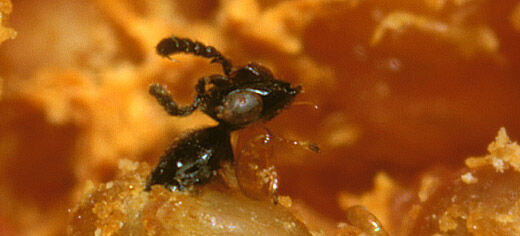
Researchers have confirmed a unique behaviour within the male population of tiny fig wasps that pollinate fig trees - they team up to help pregnant females, even if they have not mated themselves.
Published online in the Royal Society journal Biology Letters, the study confirms that placid male pollinator fig wasps work together to chew an escape tunnel for their females, before crawling back into the fig to die - the non-pollinating variety are too busy fighting each other to help.
"Male insects can cooperate to attract the attention of females or to ensure that they are successful in mating, but I don't know of any other male insects which exhibit post-mating teamwork like this," says Dr Steve Compton from the Faculty of Biological Sciences.
Fig trees are vital for rainforest ecosystems. Producing fruit all year, more birds and animals feed on them than on any other plant in the rainforest. There are more than 850 types of fig tree, each pollinated by a single uniquely adapted type of fig wasp.
The research team examined some 60,000 individual fig flowers in the laboratory, each containing either pollinating fig wasps or parasitic fig wasps. All figs contained many females but alongside these, some contained a single male and others contained several males.
The hatched young of both types mate with each other before the females attempt to escape, leaving the males to die inside the fig. "Neither type of fig wasp female is strong enough to make their own way out, so they need help from the males to do this," says Dr Compton.
Escape rates for pollinator wasps were consistently high and increased when more males were present. When only one parasitic fig wasp was present, it was just as successful as the pollinators in chewing an escape route after mating, but when several males were present, the success rates plummeted.
The study also suggests that the ability of males to cooperate is hampered by innate aggression. Of the two groups of fig wasps - those that pollinate fig trees and non-pollinators, which are parasites of the tree - only the parasitic wasps fight more for the right to mate with females, and this group were far less able to work together.
"It would seem that male parasitic fig wasps are unable to switch off the hard-wired aggression needed to successfully mate to cooperate with each other, even when their genetic investment is at stake," says Dr Compton. "Pollinators' teamwork may be prompted because of the likelihood of genetic connection to the mated females, but the parasitic fig wasps were in the same situation."
Dr Compton believes the successful collaboration between the pollinating male fig wasps studied is likely to be normal for all pollinator fig wasps. He hopes to study a highly aggressive species of pollinators, where males fight intensely, often to death. "This will shed light on whether the cooperation is present in all pollinators, or if aggressive behaviour is too difficult to switch off after mating," he says.
Image credit: Simon van Noort
For further information:
Please contact the University of Leeds Press Office on +44 (0)113 343 4031 or email pressoffice@leeds.ac.uk
Notes for editors
- The research was funded by the Ministry of Education, Pakistan.
- The research paper, titled Only pollinator fig wasps have males that collaborate to release their females from figs of an Asian fig tree, is available on request.
- The University of Leeds' Faculty of Biological Sciences is one of the largest in the UK, with nearly 150 academic staff and over 400 postdoctoral fellows and postgraduate students. The Faculty's current active research grant portfolio is around £60M and funders include charities, Research Councils, the European Union and industry. The Faculty has an outstanding research record and all major units of assessment were awarded Grade 5 in the last government (HEFCE) Research Assessment Exercise. http://www.fbs.leeds.ac.uk/